Maesa Elephant Camp: Animal Abuse?
When I was planning this trip for the team, I contemplated on including Maesa Elephant Camp into our itinerary. As a public personality, I understand the responsibility of educating and advocating the correct values. With the meteoric rise of social media, more and more people are taking what they see on social media networks as the ultimate truth without proof checking. 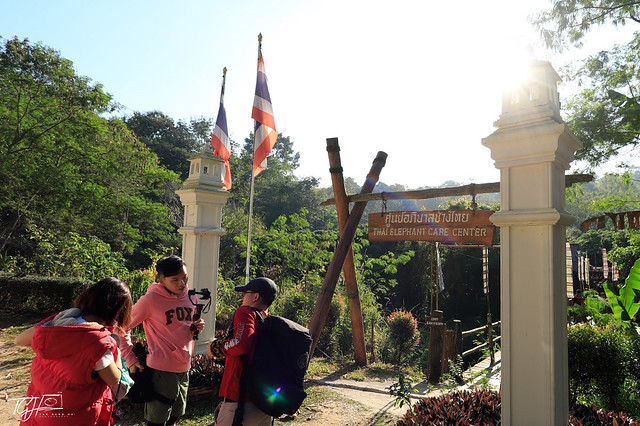 Recent years, according to animal activists, or self-proclaimed animal lover sites, some activities in Maesa Elephant Camp seem to fall into the grey area of “animal abuse”, and from what I know about the gentle giants, activities such as elephant riding, elephant shows or event elephant painting are not as clear cut as that of activities with wild animals like lions and tigers.
Recent years, according to animal activists, or self-proclaimed animal lover sites, some activities in Maesa Elephant Camp seem to fall into the grey area of “animal abuse”, and from what I know about the gentle giants, activities such as elephant riding, elephant shows or event elephant painting are not as clear cut as that of activities with wild animals like lions and tigers.
So do I want to be subjected to the scoldings and bombarding of the keyboard warriors by covering this tourist attraction even when it is promoted by the Tourism Authority of Thailand?
#EpiphanyGoChiangmai Experience the Mahout Life at Maesa Elephant Camp
As with most of my articles like Behind the Scenes of acting as a victim in Crime Watch: Sextortion to educate the public as well as my beauty reviews ie. Black Paint where I attempt to provide informed personal opinions after going through the activities myself, I decided to visit the Maesa Elephant Camp with my team and experience the programs offered.
 It is usually easy to assume what we see on Google as the ultimate truth, and condemn Maesa Elephant Camp just because we see harsh keywords like “abuse”, “cruelty” and “do not visit” pop up when we google for the location. Hence, #EpiphanyGoChiangmai decided to uncover the truth behind these slandering rumours to see if it is really so, or was it just uneducated netizens spamming wrong information?
It is usually easy to assume what we see on Google as the ultimate truth, and condemn Maesa Elephant Camp just because we see harsh keywords like “abuse”, “cruelty” and “do not visit” pop up when we google for the location. Hence, #EpiphanyGoChiangmai decided to uncover the truth behind these slandering rumours to see if it is really so, or was it just uneducated netizens spamming wrong information?
Over two days, we had a taste of what it is like being a mahout ( aka, a trainer who works with and rides an elephant) as well as a visiting tourist.
Experiencing Mini Mahout Training Course (MH401)
There’s three sections within Maesa: The Thai Elephant Care Center for the old elephants, the Maesa Elephant Nursery where the baby elephants and their mums are, and the Maesa Elephant Camp where the elephant shows, souvenir shops and tourist-y activities are held. Amongst these places, visitors who want a more in-depth and intimate experience with the elephants can go for the Basic Mahout Courses at Baan Kwan Chang.
 Due to time constraint, the Epiphany Artistry team tried out the 2 hour mini Mahout training course (MH401). During the course, we were greeted by Mahout Instructor, Tee and brought to change into our Mahout outfit as well as register for insurance. We were then given a thorough briefing on the essential information about the elephant and the Camp, the to-dos and not-to-dos when interacting with elephant.
Due to time constraint, the Epiphany Artistry team tried out the 2 hour mini Mahout training course (MH401). During the course, we were greeted by Mahout Instructor, Tee and brought to change into our Mahout outfit as well as register for insurance. We were then given a thorough briefing on the essential information about the elephant and the Camp, the to-dos and not-to-dos when interacting with elephant.
 We then watched the demonstration and learnt the Basic Commands for (bare-back) elephant riding. As there were 4 of us, all of us took turns to learn how to get up the elephant, and ride the elephant around the Nursery Ground. We’ve also learnt about the basic elephant communications and how they behave when they are happy, sad or angry.
We then watched the demonstration and learnt the Basic Commands for (bare-back) elephant riding. As there were 4 of us, all of us took turns to learn how to get up the elephant, and ride the elephant around the Nursery Ground. We’ve also learnt about the basic elephant communications and how they behave when they are happy, sad or angry.
 As the individual elephant’s mahout know their temperament best, there were times when the elephant just wish to eat or play and not move about. It was fun seeing how they behaved just like a kid. The Epiphany team then help to bath the elephant at the Maesa Stream.
As the individual elephant’s mahout know their temperament best, there were times when the elephant just wish to eat or play and not move about. It was fun seeing how they behaved just like a kid. The Epiphany team then help to bath the elephant at the Maesa Stream.
 Because of the elephant’s thick skin, they require very very stiff brushes for bathing. It was not the same as us scrubbing ourselves during bath. If you are wondering what is the strength required before they could feel anything, imagine trying to scrub a huge patch of paint off the wall with just water, you would probably need double that strength to bathe the elephant!
Because of the elephant’s thick skin, they require very very stiff brushes for bathing. It was not the same as us scrubbing ourselves during bath. If you are wondering what is the strength required before they could feel anything, imagine trying to scrub a huge patch of paint off the wall with just water, you would probably need double that strength to bathe the elephant!
 We also learnt about the various diets of the elephants, as well as how to feed baby elephants, normal elephants and elderly elephants.
We also learnt about the various diets of the elephants, as well as how to feed baby elephants, normal elephants and elderly elephants.
P.S. Do you know, each banana you feed to an elephant is equivalent to a peanut you eat? They are like minions, they love bananas for snacks!
MINI MAHOUT TRAINING COURSE:
MORNING : 9 A.M. – 11 A.M. | AFTERNOON : 2 P.M. – 4 P.M
Adult: 2500 Baht | Child: 1500 Baht (4 -8 years old)
Pro-Bareback Riding Program: Adult 1000 Baht | Child 700 Baht
Maesa Elephant Nursery
The Maesa Elephant Nursery is the place where baby elephant live with their mother until the age of 2. As the population of elephants are dropping, the nursery provides care for both the mother during pregnancy and baby elephants so that they have a higher chance of living to adulthood and past childbirth.
 Elephants reproduce in both natural way and artificial insemination at Maesa. At the nursery, we got to observe and experience lifestyle of the elephants closely. The pregnant elephants will be suspended for working when they have 10 months of pregnancy to stay at a separate house where the pregnant elephants will take a relax and be under close care of mahout and veterinary with sufficient foods and drinks.
Elephants reproduce in both natural way and artificial insemination at Maesa. At the nursery, we got to observe and experience lifestyle of the elephants closely. The pregnant elephants will be suspended for working when they have 10 months of pregnancy to stay at a separate house where the pregnant elephants will take a relax and be under close care of mahout and veterinary with sufficient foods and drinks.
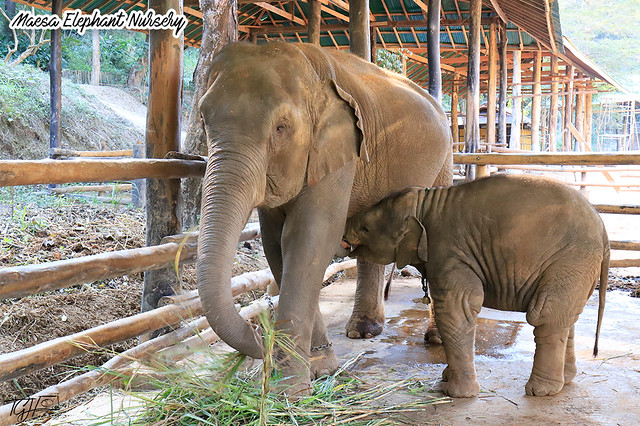 Fun Fact: Elephants stay pregnant for around 18-22 months. They produce one baby at a time, and the youngster weighs around 100 kilograms.
Fun Fact: Elephants stay pregnant for around 18-22 months. They produce one baby at a time, and the youngster weighs around 100 kilograms.
At the point of time when we were visiting, there was actually three generations of elephants under care! The grandmother (who gave birth to a new baby), the mother and another baby elephant. Some of the mothers will be really protective of their child and get agitated when strangers go near them. So for some of the mothers, we were asked to view them from far!
 There after, we learnt how to prepare some snacks using tamarind, spices and salt with Tee. We also created a cube toy out of canvas stuffed with straw for baby elephant Khun Phon.
There after, we learnt how to prepare some snacks using tamarind, spices and salt with Tee. We also created a cube toy out of canvas stuffed with straw for baby elephant Khun Phon.
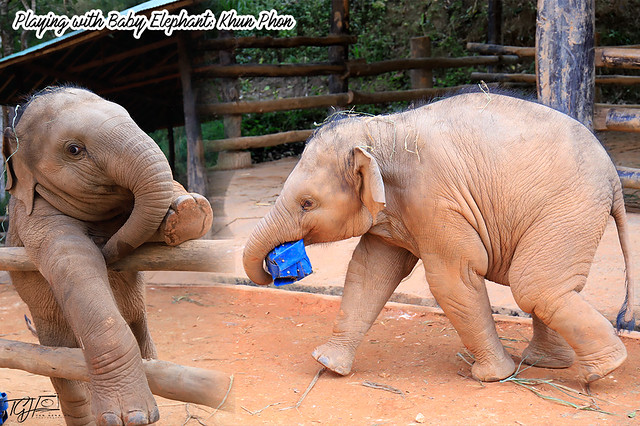 We were reminded to be careful around elephants as they do not know their strength. When Baby elephant Khun Phon gets excited, he started wanting to use his trunk to pull us in to play with him. The hair and skin of the baby elephant is much finer and thinner compared to the adult elephants.
We were reminded to be careful around elephants as they do not know their strength. When Baby elephant Khun Phon gets excited, he started wanting to use his trunk to pull us in to play with him. The hair and skin of the baby elephant is much finer and thinner compared to the adult elephants.
Entrance Fee: Adult 150 Baht | Child 100 Baht
Thai Elephant Care Center
In the past, when elephants reach their retirement age where they can no longer work, they were set free in the jungle, where they die alone. Mr. Choochart Kalmapijit, founder of the Maesa Elephant Camp tried to change the life of the elderly elephants with the Thai Elephant Care Center.
Fun Fact: Adult elephants can eat between 200-600 pounds of food a day, spending 12-18 hours a day feeding. They can also drink up to 50 gallons of water a day (That’s about as much as a standard bathtub holds!)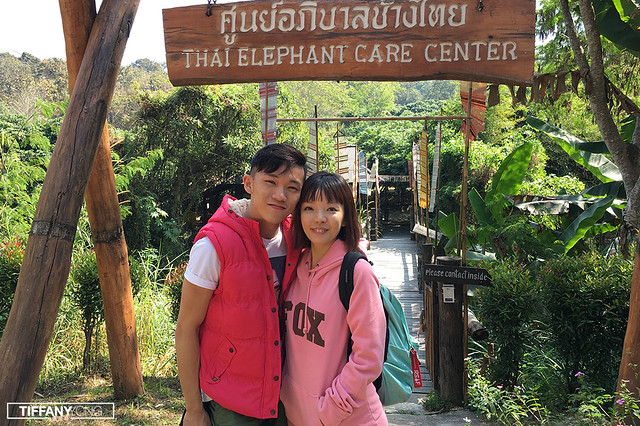 At the care center, elderly elephants were provided regular medical care and brought around for walks daily.
At the care center, elderly elephants were provided regular medical care and brought around for walks daily.
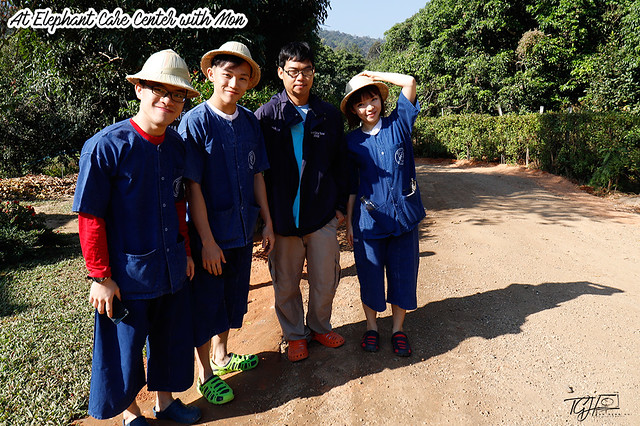 The Epiphany team were shown around the place by Mon. He addressed a lot of the concerns and issues we had (including animal abuse issues), and I was surprised how he answered them directly instead of avoiding them. He wanted us to experience and see for ourselves how the elephants were treated rather than just relying on what he said.
The Epiphany team were shown around the place by Mon. He addressed a lot of the concerns and issues we had (including animal abuse issues), and I was surprised how he answered them directly instead of avoiding them. He wanted us to experience and see for ourselves how the elephants were treated rather than just relying on what he said.
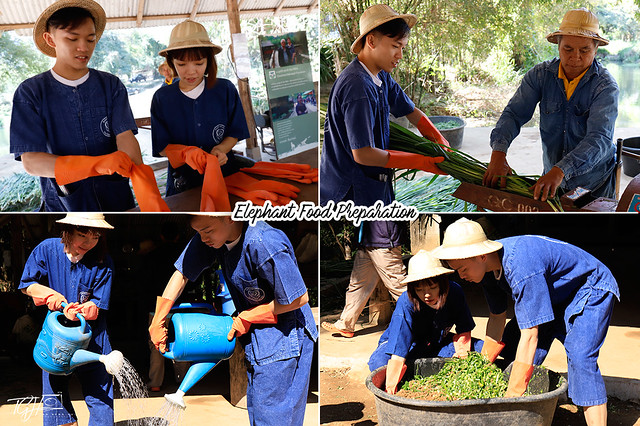 We were first introduced to the different elderly elephants by their names and their behaviours. Each of them have a distinctive personality. There will be one who is labelled the “dancing elephant”, who likes to wave her trunk and head around as if she’s dancing to music. We then had a little hands-on activity and learnt how to prepare food for the elderly elephants. As the older elephants have lost their teeth, the food go through the grinder and mixed with additional nutrition to aid their digestion.
We were first introduced to the different elderly elephants by their names and their behaviours. Each of them have a distinctive personality. There will be one who is labelled the “dancing elephant”, who likes to wave her trunk and head around as if she’s dancing to music. We then had a little hands-on activity and learnt how to prepare food for the elderly elephants. As the older elephants have lost their teeth, the food go through the grinder and mixed with additional nutrition to aid their digestion.
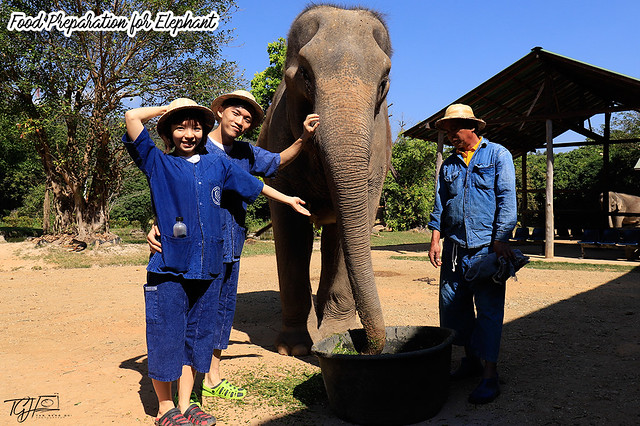 Each elephant were given food with slightly altered ratios of ingredients to match their well-being for that day. The mahout will also gauge their health based on how much they ingest.
Each elephant were given food with slightly altered ratios of ingredients to match their well-being for that day. The mahout will also gauge their health based on how much they ingest.
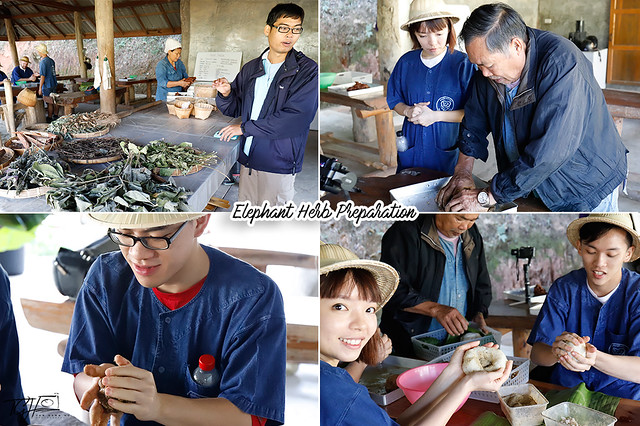 We were also introduced to the ‘Elephant Doctors’. The doctor above is equivalent to our “Traditional Chinese Medicine (TCM)” doctor as he makes medicine by using herbs. We had a hands-on activity to prepare medicine rice balls, where herbs and digestive aids (the common problem for most elderly elephants) are wrapped in glutinous rice balls and fed to the elephants.
We were also introduced to the ‘Elephant Doctors’. The doctor above is equivalent to our “Traditional Chinese Medicine (TCM)” doctor as he makes medicine by using herbs. We had a hands-on activity to prepare medicine rice balls, where herbs and digestive aids (the common problem for most elderly elephants) are wrapped in glutinous rice balls and fed to the elephants.
 The Elephant Museum provides some guides on how to differentiate the elephant species, as well as the daily activity of a typical full time mahout.
The Elephant Museum provides some guides on how to differentiate the elephant species, as well as the daily activity of a typical full time mahout.
Admission Rate: Adult 200Baht | 300Baht (with guide) | Child 150 Baht | 200 Baht (with guide)
Available Programs: Half Day (2.5 hours) Adult 2000 Baht | Child 1300 Baht
Full Day (5 hours) Adult 3000 Baht | Child 2300 Baht
2 Days | 3 Days
Bathing with Elephant Program (1 hour): Adult 1500 Baht | Child 1200 Baht
inclusive of round trip transportation and mahout uniform
Opening Hours: 8.30am – 4pm | Contact Number: 053-206-664 / 053-206-247-8
Website: https://thaielephantcarecenter.com/
Email: info@thaielephantcarecenter.com
Thai Elephant Kingdom at Maesa Elephant Camp
Last but not least, the Elephant Shows at the Maesa Elephant Camp. This is where most of the controversy lies. It would be really convenient for me to just omit this section, or even not talk about the contended issue. But I feel that this is a topic where people can argue and debate for days to almost no conclusive end, just like topics about religion, politics, or even veganism and feminism.
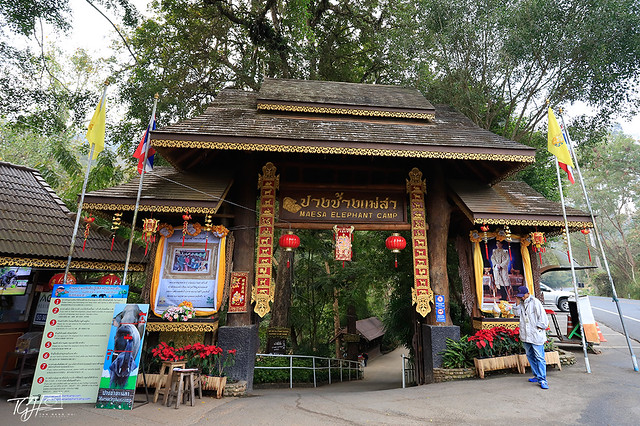 So before you jump to the conclusion and assume that I’m “promoting” tourism for Maesa Elephant Camp, I would like to present the observations as a tourist after going through a day as a mahout. You can choose to agree to disagree, or voice out your opinions by commenting below. But honestly, in my opinion, this is the most boring part of the whole camp.
So before you jump to the conclusion and assume that I’m “promoting” tourism for Maesa Elephant Camp, I would like to present the observations as a tourist after going through a day as a mahout. You can choose to agree to disagree, or voice out your opinions by commenting below. But honestly, in my opinion, this is the most boring part of the whole camp.
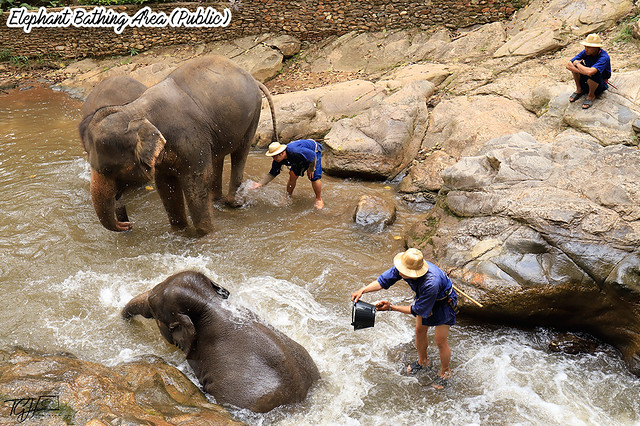 This is usually the section for tourists who are on travel packages and here to touch and go. The Maesa Elephant Camp provided a brief overlook of how the mahout bathe the elephants for the masses to see.
This is usually the section for tourists who are on travel packages and here to touch and go. The Maesa Elephant Camp provided a brief overlook of how the mahout bathe the elephants for the masses to see.
 The public is advised not to throw things at the elephants, as they will assume that it’s food and eat it. However, there will still be inconsiderate people who try their luck by throwing random objects at them. It infuriated me when I witnessed how an old man threw a pack of biscuit wrapper at the elephant.
The public is advised not to throw things at the elephants, as they will assume that it’s food and eat it. However, there will still be inconsiderate people who try their luck by throwing random objects at them. It infuriated me when I witnessed how an old man threw a pack of biscuit wrapper at the elephant.
 This is the Elephant resting zone, aka the snacking place for the elephants. Local villagers will bring their harvest (bananas and canes) to sell to the tourists, who in turn feed the elephants.
This is the Elephant resting zone, aka the snacking place for the elephants. Local villagers will bring their harvest (bananas and canes) to sell to the tourists, who in turn feed the elephants.
 At this elephant chamber, the tourists have an up-close opportunity to take photos with the elephants and interact with them.
At this elephant chamber, the tourists have an up-close opportunity to take photos with the elephants and interact with them.
The ‘Controversial’ Elephant Shows @ Maesa Elephant Camp
The elephant shows are held three times a day at 08.00 am, 09.40 am and 1.30 pm according to the elephants’ activity routine. There will be 2 groups of elephants, one called the “Chang Show” (ช้าง Chang means Elephant) and the other called the “Chang Yang” for the elephant rides. In the show, the emcee introduce the history of the elephants in Thailand, demonstrating how logging was carried out in the past before it became illegal.
In the show, the emcee introduce the history of the elephants in Thailand, demonstrating how logging was carried out in the past before it became illegal.
 There are a series of performances where the elephants showcase their intelligence and creativity through activities like painting, football kicking and dart throwing. It may seem interesting to most people, but I actually dozed off halfway through the show.
There are a series of performances where the elephants showcase their intelligence and creativity through activities like painting, football kicking and dart throwing. It may seem interesting to most people, but I actually dozed off halfway through the show.
So here comes the million dollar question:
Are these Activities Considered Animal Cruelty and Elephant Abuse?
There are several online articles discussing and emphasising several points repeatedly – the use of bull hooks and chains as well as how baby elephants were given pain and forced to hold paint brushes to do painting, something not natural to the animal’s movements when they are in their natural habitat. Are these wrong? Let’s try to answer them one by one.
 Maesa Elephant Camp tried addressing some of the concerns in their Frequently Asked Questions (FAQ). To lift some of their answers, the strength of an elephant is often undermined by human. It is assumed that the chains tied to the foot or neck were like that of those chaining and tying up human slaves, when in fact, the chains are more like a leashes or neck collars on dogs
Maesa Elephant Camp tried addressing some of the concerns in their Frequently Asked Questions (FAQ). To lift some of their answers, the strength of an elephant is often undermined by human. It is assumed that the chains tied to the foot or neck were like that of those chaining and tying up human slaves, when in fact, the chains are more like a leashes or neck collars on dogs
“Most of elephants there are the ones born in the period of forestry industry. So, the elephants are accustomed to the chain attached to them for use in dragging logs… Without chains, these elephants will not know what to do or where to stay…” Ideally elephants should not be kept on chains for prolonged periods during the day.
An elephant’s skin is generally very tough, at 2.5 cm (1 inch) thick on the back and parts of the head. A hook that you see every mahout carrying is “used for self-defense in case of elephant’s attack to the mahout because no one can stop the elephant…” when the elephant gets agitated suddenly over a sudden external threat. However, we must not overlook the fact that the hook, can indeed, be misused for punishment. Any instances of mahouts improperly using the hook should be reported.
 In terms of sheer tonnage, elephants may well be the strongest animals alive. With just their trunk, an adult elephant can lift approximately 300kg. *Studies have not been done on elephants as to how much weight it can carry on its back, but the weight carrying capacity of horses, dogs and donkeys is about 20-25% of their body weight. This equates to over 600kg for an average 3000kg elephant. With the cushioned elephant saddles, and limited working hours, two people on a saddle (approximately 150kg or less) should be less than 10% of the elephant’s weight. So elephant riding is like human carrying a backpack. While I’m not exactly comfortable with the sedan riding, I am pretty fine with bare-back riding.
In terms of sheer tonnage, elephants may well be the strongest animals alive. With just their trunk, an adult elephant can lift approximately 300kg. *Studies have not been done on elephants as to how much weight it can carry on its back, but the weight carrying capacity of horses, dogs and donkeys is about 20-25% of their body weight. This equates to over 600kg for an average 3000kg elephant. With the cushioned elephant saddles, and limited working hours, two people on a saddle (approximately 150kg or less) should be less than 10% of the elephant’s weight. So elephant riding is like human carrying a backpack. While I’m not exactly comfortable with the sedan riding, I am pretty fine with bare-back riding.
*Information provided by Asean Captive Elephant Working Group (ACEWG)
 Elephant Painting is a tricky topic. As kids, human don’t grow up knowing how to write, paint or play the piano. We were taught to do that, and sometimes, we might not even want to do that. I’m not an elephant, so I won’t know if it hurts them physically to hold a paint brush. When I voiced out this concern, one of the trainers shared about how this activity was developed when a mahout realised that the elephants were learning what the humans are doing. One might say they have hidden nails to pinch their ears, something that I definitely didn’t see with my own eyes, but we were taught how the mahout give basic commands by pulling their ears, and this gesture is like how we guide someone with our hands, because of how thick and leathery the ears are.
Elephant Painting is a tricky topic. As kids, human don’t grow up knowing how to write, paint or play the piano. We were taught to do that, and sometimes, we might not even want to do that. I’m not an elephant, so I won’t know if it hurts them physically to hold a paint brush. When I voiced out this concern, one of the trainers shared about how this activity was developed when a mahout realised that the elephants were learning what the humans are doing. One might say they have hidden nails to pinch their ears, something that I definitely didn’t see with my own eyes, but we were taught how the mahout give basic commands by pulling their ears, and this gesture is like how we guide someone with our hands, because of how thick and leathery the ears are.
Once again, I wouldn’t be able to judge what’s right or wrong here, as I can’t communicate with the elephant.
Last but not least, why not reintroduce the elephants back into the forest, to their natural habitat?
In the ideal world, all elephants should be free in nature. However, due to the increase in human population and habitat destruction, there’s not enough habitat to support the current population. Also, it is a complex process to reintroduced captive elephants back into the wild.
Elephants which had been domesticated since the logging industry (most of the elephants in Maesa Elephant Camp are domesticated) would not be able to live independently like the wild elephant. Also, they might become a pest to the tribal villages living in the mountains, and create damages to the paddy fields of the villagers near harvest time without the intention to do that. These harvest might be the main source of income of the families.
P.S. Maesa Elephant Camp is certified and controlled by ISO 9001: 2008 system on “Camp Management Services and Entertainment (Elephant Performances)”. The service is also certified by The Department of Tourism Ministry of Tourism and Sport, Thailand. The management is certified by Thailand Elephant Camp standard; Department of Livestock Development, Ministry of Agriculture and Cooperatives.
The purpose of this article is NOT to side any parties but to provide another perspective based on what we’ve observed.
How to Get to: Maesa Elephant Camp
Address: 119/9 Tapae Rd., Muang District, Chiang Mai Thailand 50100
Telephone: (+66)5320 6247, (+66)5320 6248
Email: info@maesaelephantcamp.com
For more information: Visit Maesa Elephant Camp Website | Facebook Page
xoxo

Facebook | Instagram | Twitter | YouTube
Disclaimer: No monetary compensation was received for the review. Opinions stated are genuine and honest. Also note that all sources, information, content, links are valid to change at any time.

1/2 of #TheEpiphanyDuplet, Tiffany Yong juggles her ABCs – Acting, Blogging and Coaching/Consulting as she is fuelled by passion and drive to succeed.
It is not easy to make a living in Singapore just purely based on Acting, so with Blogging to help her with her online presence, and Coaching kids drama, private tutoring and freelance social media consulting to finance her life, she is currently leading the life most people hope to have: Living the Dream!


You guys are awesome!
This is an interesting post indeed. I think I am on the fence about it all to be honest, but what I do know is that Elephants are truly beautiful animals!
An elephant camp sounds like a fun time. The pictures look amazing. Thanks for sharing.
An interesting read. I certainly do have concerns about animal cruelty and it was interesting to read your observations.
I did t even know about elephant camps. It is an interesting concept.
I enjoyed interacting with elephants during my trip to Chiang Mai. I think most elephant sanctuaries are a bit “iffy” but the one thing that I know is riding on elephants hurts the bones/muscles in their neck/back/shoulders. However, it looks like it was an enjoyable time!
What an amazing experience! The closest I’ve gotten to an elephant was in South Africa over 10 years ago lol. Glad to see you enjoyed this experience!
Thank you for sharing your experience at Maesa Elephant Camp.